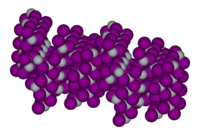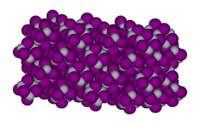- Mercury(II) iodide
-
Mercury(II) iodide 
Mercury(II) iodide (α form)
Mercury(II) iodide (β form)
α (right) and β (left) formsMercury diiodideOther namesMercuric iodideIdentifiers CAS number 7774-29-0 
ChemSpider 22893 
UNII R03O05RB0P 
DrugBank DB04445 ChEBI CHEBI:49659 
Jmol-3D images Image 1 - I[Hg]I
Properties Molecular formula HgI2 Molar mass 454.40 g/mol Appearance orange-red powder Density 6.36 g/cm3 Melting point 259 °C
Boiling point 350 °C
Solubility in water 0.06 g/L Hazards EU Index 080-002-00-6 EU classification Very toxic (T+)
Dangerous for the environment (N)R-phrases R26/27/28, R33, R50/53 S-phrases (S1/2), S13, S28, S45, S60, S61 NFPA 704 Flash point Non-flammable Related compounds Other anions Mercury(II) fluoride
Mercury(II) chloride
Mercury(II) bromideOther cations Zinc iodide
Cadmium iodideRelated compounds Mercury(I) iodide  iodide (verify) (what is:
iodide (verify) (what is:  /
/ ?)
?)
Except where noted otherwise, data are given for materials in their standard state (at 25 °C, 100 kPa)Infobox references Mercury(II) iodide (HgI2) is a chemical compound with an appearance of red-orange crystals. Unlike mercury(II) chloride it is hardly soluble in water (<100 ppm).
Conditions/substances to avoid include: heat, light, bromides, chlorides, ammonia, alkalis, cyanides, copper salts, lead salts, iodoform and hydrogen peroxide.
Mercury(II) iodide displays thermochromism; when heated above 126 °C, it undergoes phase transition from the alpha crystalline form to a pale yellow beta form. As the sample cools, it gradually reacquires its original color. It is often used for thermochromism demonstrations.[1]
Mercury(II) iodide is used for preparation of Nessler's reagent, used for detection of presence of ammonia.
Mercury(II) iodide is a semiconductor material, used in some x-ray and gamma ray detection and imaging devices operating at room temperatures.[2]
Mercury(II) iodide can be found extremely rarely in nature as mineral coccinite.
In veterinary medicine, mercury(II) iodide is used in blister ointments in exostoses, bursal enlargement, etc.
It can appear as a precipitate in many reactions.
References
- ^ Thermochromism: Mercury(II) Iodide. Jchemed.chem.wisc.edu. Retrieved on 2011-06-02.
- ^ Simage, Oy U.S. Patent 6,509,203 Semiconductor imaging device and method for producing same, Issue date: Jan 21, 2003
Mercury compounds Categories:- Iodides
- Mercury compounds
- Semiconductor materials
- Inorganic compound stubs
Wikimedia Foundation. 2010.

